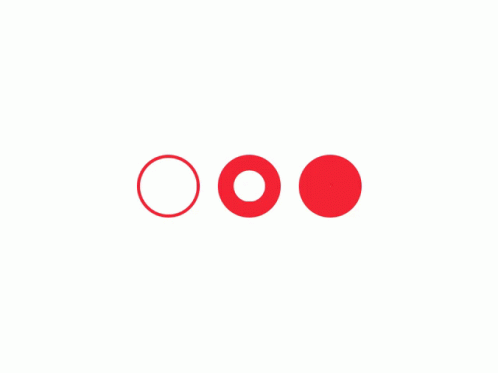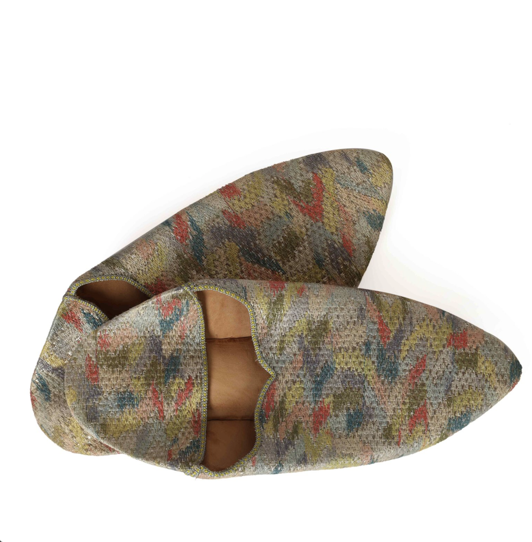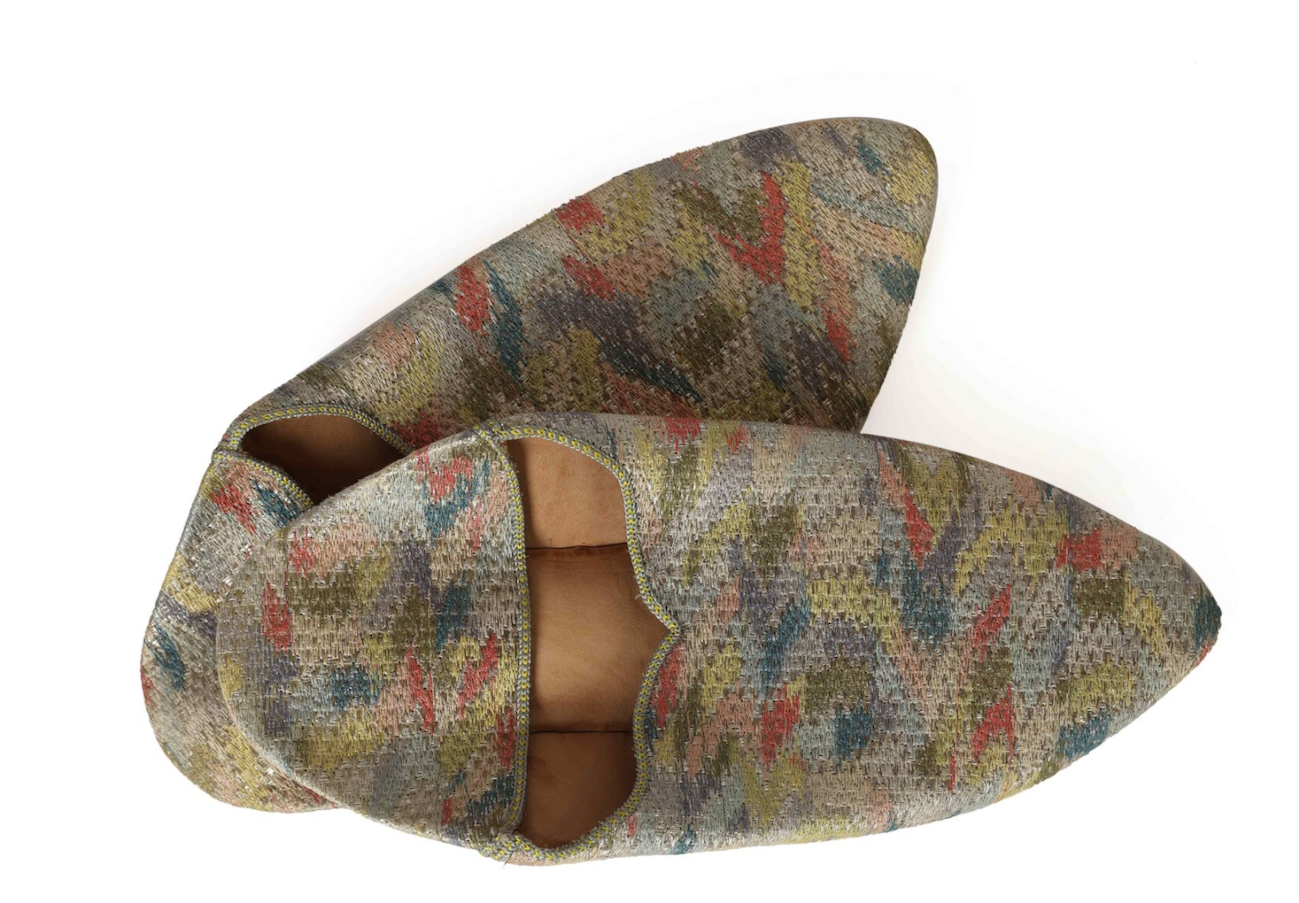




In this concluding segment of the series on traditional male attire in the Moroccan urban context, attention turns to the various forms of footwear worn by men navigating the streets of the city. As with the garments and accessories examined in the preceding instalments, traditional footwear functioned not merely as a utilitarian necessity but as a significant cultural marker, encoding distinctions of social class, professional affiliation, and regional identity. The material composition, craftsmanship, and stylistic nuances of these shoes offer critical insights into the ways in which footwear – like other elements of dress – contributed to the visual articulation of hierarchy, mobility, and everyday life within the urban fabric of Morocco.
Footwear:
Traditional footwear, most notably the ubiquitous balghah
Balghah: (Arabic, shoes), a traditional Moroccan slipper, typically handcrafted from leather, and is an integral part of the traditional attire in the Maghreb region. It features a simple design. Handmade in cities like Fez, the balghah is worn during religious and social occasions, reflecting Moroccan cultural identity.
Blāri / Balghah
Balghah: (Arabic, shoes), a traditional Moroccan slipper, typically handcrafted from leather, and is an integral part of the traditional attire in the Maghreb region. It features a simple design. Handmade in cities like Fez, the balghah is worn during religious and social occasions, reflecting Moroccan cultural identity.
In urban Morocco, the most commonly worn form of traditional male footwear was the yellow leather slipper known locally as the blāri. Distinguished by its characteristically folded heel, the blāri not only served as a practical element of everyday dress but also represented a regional variant of the widely recognized balghah
Balghah: (Arabic, shoes), a traditional Moroccan slipper, typically handcrafted from leather, and is an integral part of the traditional attire in the Maghreb region. It features a simple design. Handmade in cities like Fez, the balghah is worn during religious and social occasions, reflecting Moroccan cultural identity.

To the untrained observer, traditional Moroccan footwear may be broadly categorized into two principal stylistic forms: the curved-toe and the pointed-toe varieties. The curved-toe balghah
Balghah: (Arabic, shoes), a traditional Moroccan slipper, typically handcrafted from leather, and is an integral part of the traditional attire in the Maghreb region. It features a simple design. Handmade in cities like Fez, the balghah is worn during religious and social occasions, reflecting Moroccan cultural identity. Balghah: (Arabic, shoes), a traditional Moroccan slipper, typically handcrafted from leather, and is an integral part of the traditional attire in the Maghreb region. It features a simple design. Handmade in cities like Fez, the balghah is worn during religious and social occasions, reflecting Moroccan cultural identity. Fez: (Ottoman Turkish: fes
Fes: (synonyms: tarboush, tarbooch, tarboosh, tarbush, chachia, chechia, fez), generally red cylindrical men's felt cap with tassel. Also known as Fez after the city famous for its production in Morocco. The term is also used to denote the tassel, a bundle of suspended threads. boyası - madder to Arabic Fez – Moroccan city; Synonym: tarboush), a type of traditional skull cap with a high crown. With a possible Mediterranean origin, this headwear gained popularity in the late Ottoman period and was named after the Moroccan city where the dye was extracted.
More nuanced variations, however, were acknowledged within artisan communities, where specialized knowledge informs the classification and evaluation of traditional footwear. These subtle distinctions – often pertaining to construction techniques, materials, regional styles, and degrees of ornamentation – are documented in trade records and craft literature, reflecting a sophisticated internal discourse among practitioners that extends beyond broader public perceptions.
Within the Moroccan artisanal context, multiple variations of the balghah
Balghah: (Arabic, shoes), a traditional Moroccan slipper, typically handcrafted from leather, and is an integral part of the traditional attire in the Maghreb region. It features a simple design. Handmade in cities like Fez, the balghah is worn during religious and social occasions, reflecting Moroccan cultural identity.
In contrast, the mbentra - a lighter slipper with a thin sole made from pale, almost white leather – was traditionally favoured by scholars and men of learning, reflecting a preference for understated refinement and possibly indoor use. Perhaps the most refined and symbolically charged of these variants was the mkhousra, a high-quality slipper distinguished by its superior leather craftsmanship and elegant form. Commonly worn by high-ranking government and imperial officials, the mkhousra signified not only status but also access to elite artisanal production.
Collectively, these variations in footwear highlight the subtle yet significant ways in which material, form, and usage articulated distinctions of class, profession, and cultural capital within the landscape of traditional Moroccan urban dress.
Teqāchīr
In addition to the blāri or balghah
Balghah: (Arabic, shoes), a traditional Moroccan slipper, typically handcrafted from leather, and is an integral part of the traditional attire in the Maghreb region. It features a simple design. Handmade in cities like Fez, the balghah is worn during religious and social occasions, reflecting Moroccan cultural identity.
Over time, however, the adoption of socks expanded beyond generational boundaries, influenced in part by the increasing circulation of European fashion and dress norms in Morocco. The growing availability of mass-produced socks, facilitated by expanding trade networks and industrial manufacturing, contributed to their normalization across diverse age groups and socio-economic classes.
This gradual shift to European imported hosiery, well-documented in colonial-era fashion journals and trade records not only reflects changing patterns of consumption but also illustrates how external sartorial influences were selectively integrated into local practices, reshaping the daily expressions of dress within the Moroccan urban landscape.
In conclusion, the examination of different traditional attires within the urban Moroccan male wardrobe reveals a richly textured interplay between functionality, craftsmanship, and social symbolism. Accessories such as the mdomma, hizām, and kourziya also served as structural supports for layered garments as well as markers of status, occupation, and cultural identity, with distinctions in material and design often reflecting regional and communal affiliations. Likewise, variations in footwear – from the blāri and its specialized forms – mséita, mbentra, and mkhousra – further underscores the nuanced visual codes that were embedded in male dress. The integration of ancillary elements also demonstrates how evolving generational practices, and external influences shaped the continuity and transformation of local dress traditions over time.
Having thus surveyed the principal accessory components of traditional male attire, the series will now turn to the richly layered world of traditional women's dress in the urban Moroccan context. The forthcoming segment will explore the garments, adornments, and textile practices that defined female appearance in public and private spheres, offering insight into how women's clothing similarly articulated identity, aesthetics, and socio-cultural belonging in the dynamic fabric of Moroccan urban life.